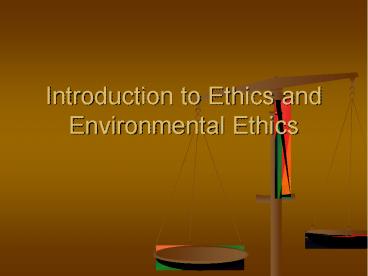Introduction to Ethics and Environmental Ethics - PowerPoint PPT Presentation
Title:
Introduction to Ethics and Environmental Ethics
Description:
Practical Ethics. Some Neighbors of Ethics. Religion. Law. Politics. Economics. Other Social Factors ... Justice has practical significance. Justice ... – PowerPoint PPT presentation
Number of Views:655
Avg rating:3.0/5.0
Title: Introduction to Ethics and Environmental Ethics
1
Introduction to Ethics and Environmental Ethics
2
Some Classic Characteristics of Ethics
- Central concern is the well-being of people.
- Consider not just yourself, but also all others
who stand to be affected. - Moral evaluations and judgments should be
impartial. - Moral evaluations and judgments should be
universalizable. - Moral evaluations and judgments are inescapable.
- Moral considerations typically override other
considerations.
3
Approaches to Ethics
- Metaethics and Conceptual Analysis
- Descriptive Ethics
- Normative Ethics
- Practical Ethics
4
Some Neighbors of Ethics
- Religion
- Law
- Politics
- Economics
- Other Social Factors
5
Some Challenges to Ethics
- Ethical Nihilism ethics do not exist.
- Cultural Ethical Relativism ethics are relative
to particular cultures. - Individual Ethical Relativism ethics are
relative to particular individuals.
6
Traditional Ethical Theories The Big Picture
7
Moral Principles
- Principle of Nonmaleficence
- Principle of Beneficence
- Principle of Utility
- Principle of Respect for Autonomy
- Principle of Justice
8
Introducing JusticeHarry Brighouse
- Justice can help us navigate between conflicting
values. - Justice can help steer social science and policy.
- Justice has practical significance.
9
Justice
- Classic Formulation of Formal Justice Equals
must be treated equally, and unequals must be
treated unequally. - So what counts as relevant conditions for equal
or unequal treatment?
10
Material Conditions of Justice
- Equal and unequal treatment concerns how
- burdens and benefits are distributed. This could
- be based on some of the following
- 1. Need 6.
- 2. Effort 7. Race and Ethnicity
- 3. Contribution 8. Gender
- 4. Merit 9. Economic Class
- 5. Full Equality 10. Country of Origin
11
Distributive Justice
- This concerns what material conditions are used
to determine how burdens and benefits are
distributed. - Distributive Justice Equity.
- Most past and contemporary theories of justice
focus almost exclusively on distributive justice.
12
Environmental Ethics
- Robert Elliot
13
How can we justify a particular environmental
ethic?
- 1. Anthropocentrism
- a. Use traditional moral theories
- b. Create some new ethical theory or
approach - 2. Moral Extensionism
- 3. Novel Features Approach
14
How can we flesh out a particular environmental
ethic?
- 1. Anthropocentrism
- a. Strong
- B. Weak
- C. Economics-Based
- D. Future Generations
- 2. Zoocentrism (variants include psychocentrism
and sentientism) - 3. Biocentrism
15
More Ways to Flesh Out an Environmental Ethic
- 4. Ecocentrism
- 5. Universal Moral Consideration
- And the three radical ecologies
- 6. Social Ecology
- 7. Deep Ecology
- 8. Ecological Feminism or Ecofeminism
16
- Environmental Ethics are based on values.
- But what are values?












![⚡Read✔[PDF] Postcolonial Theory: A Critical Introduction: Second Edition PowerPoint PPT Presentation](https://s3.amazonaws.com/images.powershow.com/10047411.th0.jpg?_=20240604111)


















